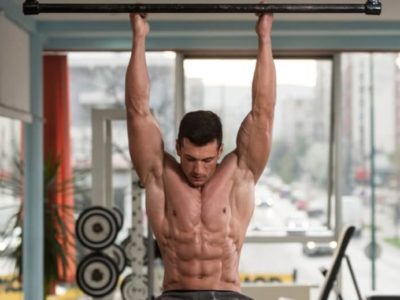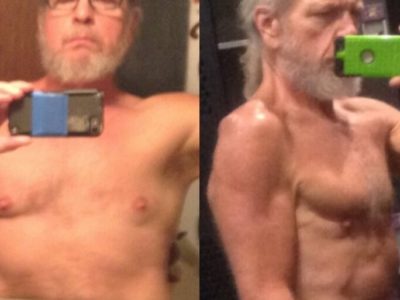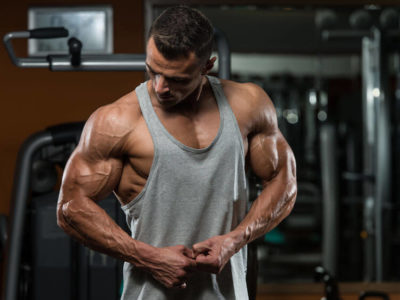
Few exercises are as visually stunning as a well-executed power clean:
Someone rips a loaded barbell off the floor, swings it overhead, drops into a quarter squat to catch it on their shoulders, and then stands up.
In addition to looking cool, the power clean is also one of the best exercises for developing explosive speed and power, which can aid your performance in most sports.
As you’d expect, learning how to power clean takes time, patience, and proper instruction. You’ll have to supply the first two ingredients on your own, but keep reading, and you’ll learn everything you need to know about power clean form. You’ll learn . . .
- What a power clean is
- What the benefits of the power clean are
- The muscle worked by the power clean
- Common power clean mistakes
- Some of the best power clean variations, like the hang power clean, power clean and jerk, and the dumbbell power clean
And at the end, you’ll get a fun, effective, and challenging power clean workout.
What Is a Power Clean?
The power clean is a strength exercise that involves lifting a barbell from the floor onto your shoulders in one continuous movement.
It’s used by athletes in a variety of sports to improve power, coordination, and strength, including football, rugby, and hockey. Many Olympic weightlifters also use it as an accessory exercise to improve their performance on the clean-and-jerk and snatch exercises. (An accessory exercise is an exercise that improves your ability to do another exercise).
The power clean has become increasingly popular due to its inclusion in CrossFit workouts, but it’s been included in various strength programs like Starting Strength and Jim Wendler’s 5/3/1 for decades.
This can also be a source of confusion, because you’ll see people refer to the Olympic power clean, Starting Strength power clean, and CrossFit power clean as if they’re different exercises. In reality, the power clean in CrossFit, Starting Strength, Olympic weightlifting, and every other program, is exactly the same.
What does sometimes differ is how the exercise is taught, with different coaches preferring different cues, instructions, and progressions. The end result, though, is identical (otherwise, it wouldn’t be a power clean).
Power Clean Benefits
The power clean trains almost every major muscle group in your body, and the main muscles worked by the power clean are the . . .
- Quadriceps
- Hamstrings
- Glutes
- Calves
- Deltoids
- Abdominals
- Trapezius
- Erector spinae
That said, it’s important to say right off the bat that the power clean is not a great exercise for building muscle. The reason for this is that it works best when used with relatively light weights for very few reps (usually just one rep per set), which research shows isn’t going to move the needle when it comes to muscle growth. This is why you’ll rarely see it included in bodybuilding or powerlifting programs.
The main benefit of the power clean is that it can improve athletic performance across a wide variety of sports, and it does this in three ways:
1. It develops full-body power.
Strength and power are slightly different.
Strength refers to your ability to generate maximum force to overcome resistance. Sports like powerlifting require a lot of strength because they require you to lift as much weight as possible, but you don’t necessarily have to lift the weight very quickly.
Power refers to your ability to generate force quickly. Most sports—like basketball, football, and wrestling—require you to generate force rapidly, but not necessarily the most absolute force.
For example, if you deadlift 400 pounds, but it takes you 3 seconds to finish the rep, you’re very strong but not very powerful. If you can deadlift 200 pounds in 0.2 seconds, though, you’re still (kind of) strong but very powerful.
Thus, power is force plus speed.
The power clean requires you to lift weights as quickly as possible, which develops the type of power you need to perform well on the field, court, or track.
2. It trains multiple “movements” at once.
There are seven basic movement patterns that the human body can perform:
- Push
- Pull
- Squat
- Lunge
- Hinge
- Rotation
- Gait
Most exercises you do in the gym train one of these movements patterns at a time. For instance, when you perform the bench press you train the “push” movement pattern, and when you perform the squat, you train the “squat” movement pattern (astonishingly).
In the power clean, however, you explosively hinge at the hips to get the bar moving off the floor, then catch the bar in a squat and stand up, which means you train two movement patterns simultaneously—hinge and squat.
(According to some coaches, you also “pull” yourself under the bar during the “catch” phase of the lift, which would mean you train three movement patterns at once, but this seems like a bit of a stretch.)
Since most sports (powerlifting and bodybuilding being two obvious exceptions) require you to use a variety of different movement patterns, training them under load using an exercise like the power clean can be an effective way to boost your athletic performance.
3. It improves your ability to do triple flexion and extension.
Triple what?
As a corollary to the last point, most sports involve two specific combinations of movement patterns—triple extension and triple flexion.
Triple extension refers to the simultaneous straightening (or extension) of the ankles, knees, and hips, whereas triple flexion is the exact opposite—the simultaneous bending (or flexion) of the ankles, knees, and hips.
A good example of triple extension is jumping straight up into the air, and landing is simply the inverse—triple flexion.
Being able to explosively perform triple extension enables you to jump higher, sprint faster, and change direction at speed, while triple flexion enables you to absorb force effectively, which is important for avoiding injuries, especially in contact sports like hockey, football, and rugby.
The power clean effectively trains both triple extension and triple flexion and allows you to use progressively heavier weights so you continue to gain strength and power over time.
How to Power Clean
Before we get into the specifics of power clean form, make sure you have all the equipment you need to do the power clean correctly, including . . .
- A barbell
- Bumper plates
- Weightlifting chalk (optional)
- Weightlifting shoes (optional)
With that taken care of, let’s talk about how to do a power clean with proper technique.
Step 1: Set up
Walk up to a loaded barbell, position your feet so your heels are about six inches apart with your toes pointed slightly out, and move the bar about an inch away from your shins. Grab the bar with a double-overhand grip (palms facing toward you) just outside your shins. Squat down so that your thighs are about parallel to the floor, your shoulders are slightly ahead of the bar, your arms are straight, your back is flat, and your chest is up.
Tip: Rotate your arms so that the insides of your arms touch your knees and your elbows point directly out to the sides. This will keep your arms in the optimal position throughout each rep.
Step 2: First Pull
Without bending your back and while keeping the bar close to your shins, explosively pull the bar upward by straightening your knees and hips. Your arms should stay straight and your head should be in line with your spine.
Step 3: Second Pull
As the bar passes your knees, lean backward slightly and push your knees forward so that they’re under the bar. Once the bar is between your knee and mid thigh, straighten your hips, knees, and ankles as if you were jumping, so that your thighs make contact with the bar. At the same time, forcefully shrug your shoulders. When your shoulders are shrugged as high as possible, allow your elbows to bend as the bar travels up your body.
Step 4: Catch
As the bar reaches its maximal height, pull your body underneath the bar by driving your elbows out in front of you, just as you would when setting up for a front squat. Quickly drop into a quarter squat by bending at the hips, knees, and ankles, then catch the bar across the front of your shoulders so that it rests along your collarbone.
Step 5: Ascend
As soon as you’ve regained your balance, drive through your feet to stand up straight. Make sure you keep your head in a neutral position and your back straight or slightly arched.
Step 6: Descend
While maintaining your grip on the bar, allow it to fall down the front of your body by pulling your elbows back behind it until your arms are straight and the bar is resting just below your waist. Let the bar slide straight down your thighs while moving your hips backward until the bar has cleared your knees, and then drop it to the floor.
Don’t try to lower the bar slowly or quietly. The entire descent should take 1-to-2 seconds or less. Take a moment to get into the proper starting position, then start your next rep.
Common Power Clean Mistakes
Pulling with your arms.
The problem: Many people make the mistake of pulling the bar up to their shoulders using their arms like an upright row instead of letting the energy from the “second pull” propel the bar upward. This causes you to bend your elbows too soon, which wastes energy and makes the rep considerably harder to complete.
The fix: Using an empty barbell, run through the “first pull” and “scoop” steps of the lift, but instead of bending your elbows as the bar travels up your body, keep them straight. If you’re doing this drill correctly, you should look like you’re jumping and doing a barbell shrug at the same time. Complete four reps like this, then on your fifth rep catch the bar on the front of your shoulders. Repeat this drill a few times at the beginning of your power clean workout each week, and it won’t be long until you ingrain the correct motor pattern.
Not catching the bar in the correct position.
The problem: Because catching the bar on your shoulders—and thus very close to your face and neck—seems like a good way to knock your teeth out, you’ll often see people trying to hold the bar in their palms with their forearms vertical, as if they were setting up to overhead press. This may seem like a safer option in the beginning, but it actually increases your risk of injuring your wrists and elbows, makes it hard to control the bar, and can make balancing after the “catch” more difficult.
The fix: Before you get too serious about power cleans, make sure you have the shoulder and wrist flexibility to get into a good front rack position (the same position you use when setting up for the front squat). Once you can get in the proper front rack position without pain, practice doing the entire exercise with an empty barbell, and only add weight once you’re comfortable with catching the barbell on the top of your shoulders.
Using too much weight.
The problem: The power clean resembles the deadlift and the front squat, but that doesn’t mean you should load it the same way. The whole goal of the power clean is to move the weight as quickly as possible, not move as much weight as possible. Trying to do so negates the benefits of the exercise, scrambles your technique, and increases your risk of injury.
The fix: Testing your one-rep max on the power clean from time to time is fine, but most of your sets should be done using 60-to-80% of your one-rep max for sets of 1-to-5 reps. In other words, most reps should feel pretty easy.
Power Clean Variations
There are two main lifts in Olympic weightlifting: the clean and jerk and the snatch.
To prepare for the clean and jerk—an exercise that involves lifting, or “cleaning,” a weight up to your shoulders, then pressing it above your head—Olympic weightlifters use several “clean” variations to practice and strengthen each portion of the exercise.
The power clean is one of these variations, but there are a few others worth learning about, too (if only so you don’t get them confused).
Hang Clean vs. Power Clean
The hang clean differs from the power clean in two ways:
- Instead of starting from the floor, the hang clean starts from the “hang position”—a position somewhere between the “first pull” and the “second pull,” where the bar “hangs” at around knee height.
- Unlike in the power clean where you “catch” the bar in a quarter squat, in the hang clean you “catch” the bar in a full squat position before standing up. That is, your butt is much closer to the ground when the bar lands on your shoulders.
The hang clean emphasizes the second phase of the clean and jerk—catching the bar on your shoulders and standing up with the bar—whereas the power clean emphasizes the initial pull from the floor.
Hang Power Clean vs. Power Clean
The only difference between the hang power clean and the power clean is the former starts from the “hang” position with the bar at about knee height, whereas the latter starts from the floor (as described above).
This enables you to practice the “second pull” and “catch” portion of the lift, without using a lot of energy pulling the weight from the floor or squatting the weight after the “catch.”
Note: Sometimes you’ll hear people talk about the “CrossFit hang power clean” as if it’s different from the standard hang power clean. This isn’t the case—both exercises are exactly the same. The only difference is the former is a term sometimes used specifically in CrossFit circles.
Clean vs. Power Clean
The only difference between the clean and the power clean is in the clean you “catch” the bar in a full squat instead of a quarter squat position.
In the clean you practice all of the movements that make up the clean portion of the clean and jerk.
Power Clean and Jerk vs. Power Clean
Once you stand up from the quarter squat in the power clean, the only remaining step is to lower the bar and prepare for your next rep.
In the power clean and jerk, however, after you stand up from the quarter squat you then immediately perform a push press.
Olympic weightlifters often use this exercise to practice the transition between “cleaning” the weight up to your shoulders and pressing the weight overhead.
Dumbbell Power Clean vs. Power Clean
The dumbbell power clean and the power clean are the same exercise, except the dumbbell power clean is performed with dumbbells, and the power clean is performed with a barbell.
This is a good power clean variation if you don’t have access to a barbell, but it doesn’t have as much carryover to Olympic weightlifting.
Power Clean Workout
Since the power clean is primarily a lower body exercise, most strength training programs include it in a lower-body workout.
When you do power cleans in your workout really depends on your goals and experience level.
If you’re still learning how to power clean, it makes sense to do them at the very beginning of your workout when you’re feeling fresh. Then, simply carry on with the rest of your lower-body workout.
If you’ve already learned proper power clean technique, though, and your main goal is gaining muscle and strength, it makes more sense to do a lower-body compound exercise first, such as the squat, and then do power cleans.
Here’s a simple and effective power clean workout that includes several other exercises to train your quads, glutes, and hamstrings.
- Barbell Back Squat: 3 sets of 4-to-6 reps with 2-to-3 min rest
- Power Clean: 3 sets of 5 reps at 70% of one-rep max with 2-to-3 min rest
- Dumbbell Lunge: 3 sets of 8-to-10 reps with 2-to-3 min rest
- Lying Hamstring Curl: 3 sets of 8-to-10 reps with 2-to-3 min rest
+ Scientific References
- Comfort, P., Allen, M., & Graham-Smith, P. (2011). Comparisons of peak ground reaction force and rate of force development during variations of the power clean. Journal of Strength and Conditioning Research, 25(5), 1235–1239. https://doi.org/10.1519/JSC.0b013e3181d6dc0d
- Hori, N., Newton, R. U., Andrews, W. A., Kawamori, N., Mcguigan, M. R., & Nosaka, K. (2008). Does performance of hang power clean differentiate performance of jumping, sprinting, and changing of direction? Journal of Strength and Conditioning Research, 22(2), 412–418. https://doi.org/10.1519/JSC.0b013e318166052b
- M H Stone, R Byrd, J Tew, & M Wood. (n.d.). Relationship between anaerobic power and olympic weightlifting performance – PubMed. Retrieved June 1, 2021, from https://pubmed.ncbi.nlm.nih.gov/7442234/
- Marques, M. C., & Izquierdo, M. (2014). Kinetic and kinematic associations between vertical jump performance and 10-m sprint time. Journal of Strength and Conditioning Research, 28(8), 2366–2371. https://doi.org/10.1519/JSC.0000000000000390
- Schoenfeld, B. J., Grgic, J., Ogborn, D., & Krieger, J. W. (2017). Strength and hypertrophy adaptations between low- vs. High-load resistance training: A systematic review and meta-analysis. In Journal of Strength and Conditioning Research (Vol. 31, Issue 12, pp. 3508–3523). NSCA National Strength and Conditioning Association. https://doi.org/10.1519/JSC.0000000000002200
If you enjoyed this article, get weekly updates. It’s free.
Sending…
Great! You’re subscribed.
100% Privacy. We don’t rent or share our email lists.





